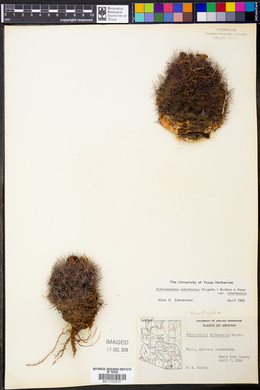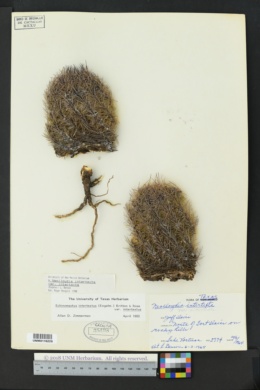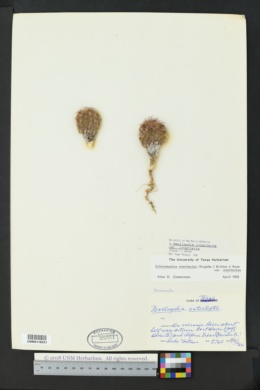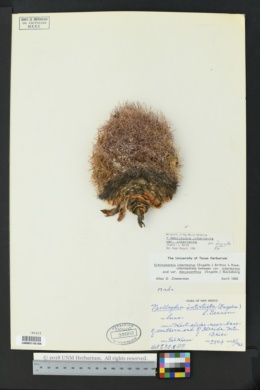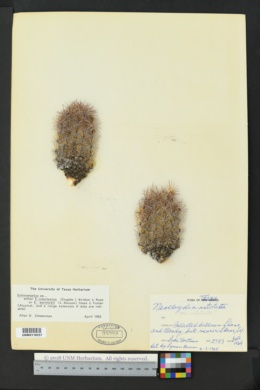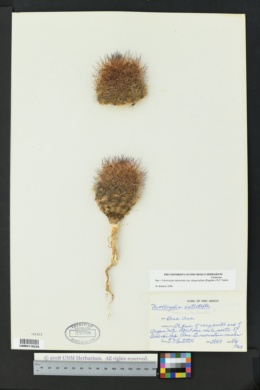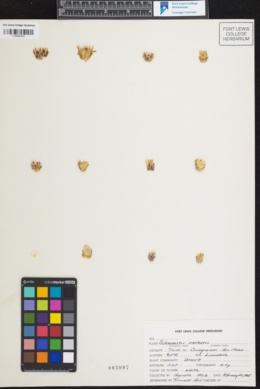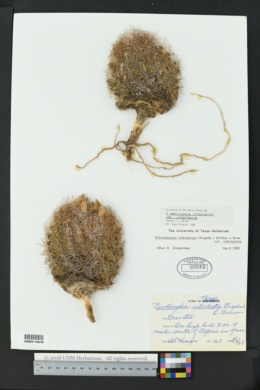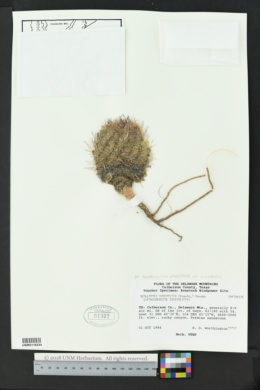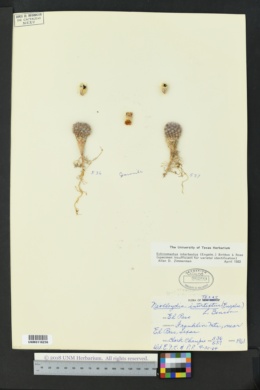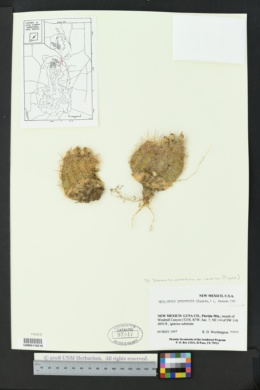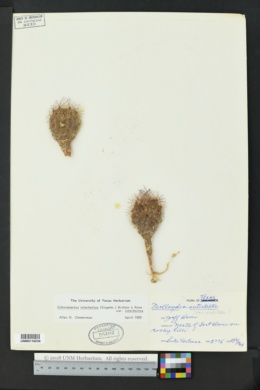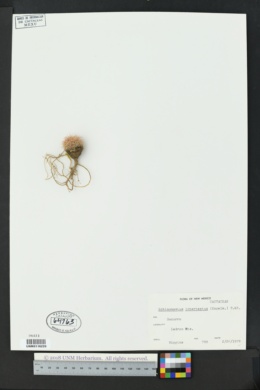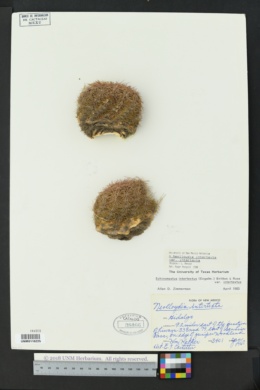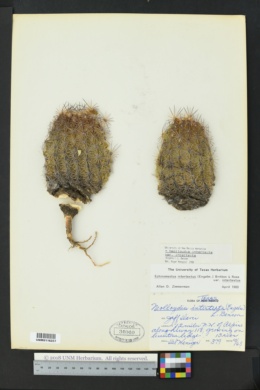Echinomastus intertextus
|
|
|
|
Family: Cactaceae
White Fish-Hook Cactus, more...white fishhook cactus
[Sclerocactus intertextus var. intertextus] |
Stems 5-17(-20) × 3-10 cm; ribs ca. 13; areoles (5-)9-11 mm apart along ribs; areolar glands absent. Spines 20-29 per areole, dull tan to pale gray, pinkish, or reddish brown (rarely dull white or straw colored), usually tipped reddish brown; radial spines 13-25 per areole; abaxial (shortest) radial spine 5-13 × 0.2-0.4 mm; adaxial and lateral (longest) radial spines 9-20 mm; central spines (3-)4 per areole, abaxial central spine porrect, straight or nearly so, (0-)0.5-14(-20) mm; others 10-18(-20) × 0.2-0.5 mm. Flowers 2.5-3(-3.8) × 2.5-3(-3.8) cm; inner tepals silvery white to pale lavender pink (rarely white with pale pink midstripes), 1.3-2.5 cm × (1-)3-5.5 mm; stigma lobes bright red or pink (rarely white). Fruits immediately dehiscent through wide basal pore (= circumscissile abscission scar), ± spheric, 6-15 × (6-)8-15 mm. 2n = 22. The mature part of the stem of Echinomastus intertextus is sometimes positioned above ground level on a stalklike proximal part of the stem, which often remains narrowly cylindric while the distal part broadens to the normal diameter of the adult stem. This contrasts with the other species of Echinomastus, which lack a stalklike stem portion between the roots and mature part of the stem. Many populations of E. intertextus are intermediate between the two varieties, i.e., they contain a wide range of central spine lengths. Consequently, sampling error (usually only one specimen from each population) created the illusion of extensive sympatry between long-spined and short-spined varieties.
FNA 2003, Correll and Johnston 1970, Allred and Ivey 2012 Common Name: white fishhook cactus Duration: Perennial Protected Status: No status in Arizona. General: Solitary-stemmed hedgehog-type cactus; stems erect and usually unbranched, ovoid to depressed-hemispheric, 5-20 cm tall and 3-10 cm diameter, pale to dark green or glaucous bluish-green; stems with about 13 ribs, the crests deeply notched above each areole (axillary buds from which the spines emerge); areoles elliptic, about 1 cm apart. Spines: Spines fine and straight, gray to tan, brown, or reddish and frequently red-tipped, 20-29 per areole, with usually 3-4 central spines and 13-25 radial spines (spines emerging from the outside edge of the areole); central spines up to 2 cm long, the lowest one sticking straight out and obviously a central spine, but sometimes only a few mm long; the upper 3 central spines appearing radial, about 2 cm long; radial spines of differing lengths, ranging from 5 mm to 2 cm long, overlapping the radial spines of other areoles. Flowers: Flowers about 3 cm high; petals numerous, 2 cm long and 3-5 mm wide, silvery white to pale lavender pink, or rarely white with pale pink midstripes; stigma lobes bright red or pink, or rarely white. Fruits: Fruits subcylindric to subspheric, 6-15 mm long, fleshy and green when fresh but drying and turning tan or reddish brown at maturity; seeds black, to 2 mm wide. Ecology: Found on limestone and igneous substrates in deserts, grasslands, and pinyon-juniper woodland, from 1,000-7,000 ft (305-2134 m); flowers February-April. Distribution: s AZ, s NM, w TX. Notes: With its slender, straight, spreading spines, this species strongly resembles a Coryphantha sp. However, Coryphantha spp. have extremely well-defined, deeply separated tubercles. For example the common and widespread C. vivipara has tubercles that protrude 6-19 mm, compared to E. intertextus, with reasonably well defined tubercles that protrude only about 3 mm. The mature part of the stem of Echinomastus intertextus is sometimes positioned above ground level on a stalklike proximal part of the stem, which often remains narrowly cylindric while the distal part broadens to the normal diameter of the adult stem; this trait distinguishes it from other species on Echinomastus. There are two varieties: var. intertextus has radial spines that are closely appressed to the cactus stem, and a primary central spine (the one that sticks straight out) less than 5 mm long. Var. dasyacantha has diffusely spreading radial spines which are not closely appreassed to the cactus stem, and the primary central spine is longer, about 2 cm long. Ethnobotany: Unknown Etymology: Echinomastus comes from from the Greek echinos, a spiny, and masto for a breast, alluding to the spiny, nipple-like tubercles; intertextus means intertwined, referring to the overlapping spines. Synonyms: Echinocactus intertextus, Neolloydia intertexta, Sclerocactus intertextus Editor: LCrumbacher 2010, AHazelton 2017 |
|
|
|



























